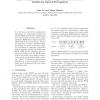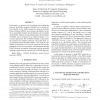11 search results - page 1 / 3 » Implicit Trajectory Modeling through Gaussian Transition Mod... |
NAACL
2003
13 years 5 months ago
2003
It is well known that frame independence assumption is a fundamental limitation of current HMM based speech recognition systems. By treating each speech frame independently, HMMs ...
CSL
2007
Springer
13 years 4 months ago
2007
Springer
Hidden Markov Models (HMMs) are the most commonly used acoustic model for speech recognition. In HMMs, the probability of successive observations is assumed independent given the ...
ICASSP
2011
IEEE
12 years 8 months ago
2011
IEEE
In this paper, we present a novel technique for modeling the posterior probability estimates obtained from a neural network directly in the HMM framework using the Dirichlet Mixtu...
ICASSP
2009
IEEE
13 years 11 months ago
2009
IEEE
In this work we show how conditional mean imputation can be bounded through the use of box-truncated Gaussian distributions. That is of interest when signals or features are partl...
ICPR
2008
IEEE
13 years 11 months ago
2008
IEEE
With the increasing demand for spoken language interfaces in human-computer interactions, automatic recognition of emotional states from human speeches has become of increasing im...


